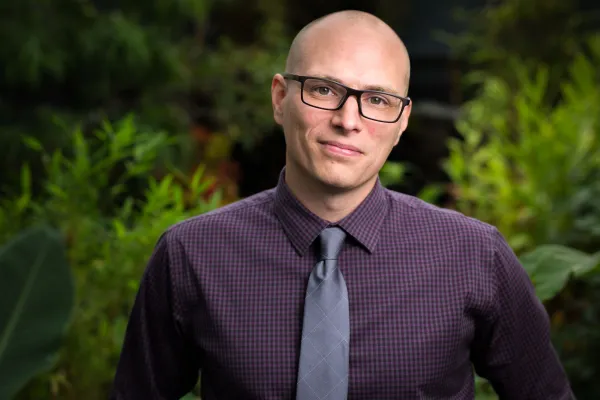Telling the Stories of Smith’s Remarkable Plant Collection
Research & Inquiry

Published September 27, 2017
On a whiteboard in Tim Johnson’s office in Lyman Plant House, the words “Big Stuff” headline a list of ideas for the future.
Climate change education, landscaping for a new Neilson Library and sustainability are among the topics that Johnson and the staff of the Smith Botanic Garden are exploring.
Since he began work as director of the Botanic Garden this summer, Johnson has been struck by how deeply the college community cares about its more-than-100-year-old “living museum.”
“Lots of colleges have botanic gardens, but they’ve often been pushed to the sidelines,” he notes. “Here, the Botanic Garden has been able to adapt and reinvent itself to continue to meet the needs of our students and faculty.”
A plant scientist and former head of preservation at the international nonprofit Seed Savers Exchange, Johnson says he’s looking forward to finding new ways to “tell the stories” of Smith’s outstanding plant collection.
Johnson will host a meet-and-greet for college community members and Botanic Garden visitors on Saturday, Oct. 14, from noon to 1 p.m. at Lyman Plant House.
Here’s what he had to say about the work of the Botanic Garden.;
What’s struck you most in your first few months at Smith?
“There are so many students doing internships and people interested in the Botanic Garden—and that’s great! Staff members here are really outstanding—highly skilled and giving of their knowledge. We’re talking about ways the Botanic Garden can play a role in building a more just, inclusive and equitable world. I think that at Smith, we can really be a leader in that.”
How is the Botanic Garden contributing to sustainability efforts at Smith?
“We’re starting to brainstorm ideas and talk with other departments. We’re exploring how we might turn Lyman Plant House into a model of energy efficiency. We’re also sharing ideas with Dining Services and the Center for the Environment, Ecological Design and Sustainability about whether we can do more food production on campus. CEEDS is already producing maple sugar at the MacLeish Field Station. There are a lot of other areas at Smith where we could showcase sustainable food.”
What about climate change?
“That’s a big issue—how the Botanic Garden can facilitate climate change literacy and also mitigate the impact of climate change on our collection. There’s a special studies group that’s looking at climate change initiatives across the campus in anticipation of developing a master site plan for Smith. As part of that, we’re looking at what lessons we can learn from the past and what themes and initiatives we want to take on. We hope to develop an original exhibit about climate change and also to improve our signage so that it’s infused with information about climate change.”
How will you tell the stories of plants at Smith?
“It’s interesting to see how knowing the cultural context of a plant can create value. Saying, ‘Here’s a tree’ is different from saying ‘Here’s a tree that’s been growing on campus for more than 70 years.’ Documenting how a particular specimen came to Smith and how a faculty member has used it in their research is one way for us to tell those stories. Another idea that predates me is to do an exhibit in our gallery space elevating the work of Blanche Ames Ames (class of 1899). She was married to Oakes Ames, a famous botanist. But while he gets a lot of credit for his work, her contributions are not well known. And there’s the story of how so many of the plants we rely on originally came from countries that are now impoverished—how the Global North has benefited from the botanic diversity of the Global South.”
How are you using technology to carry out your mission?
“We’ve just launched TreeSpeak, a mobile website that students in horticulture classes have been working on. They’ve researched trees on campus and have recorded audio messages about 30 Smith trees you can access online and with a smartphone. Just look for the TreeSpeak signs and QR codes on trees in the arboretum. We’ve begun using Instagram (@smithcollegebotanicgarden) and other social media to help showcase the beauty of our campus and to show how students are engaged in the work of the Botanic Garden. We’re also talking about the possibility of using augmented reality similar to Pokémon GO. So, you might be looking at an existing landscape on campus, and through a device you could superimpose a view of what that landscape looked like previously.”
What’s something that’s brand new at the Botanic Garden this fall?
“We are just finishing up the rehabilitation of the Japanese Garden near Paradise Pond. We’ve been working with a new designer, John Powell, who has ideas for some different plantings in that location. We want the garden to continue to be a place of respite and refreshment. We’ll hold a rededication for the finished Japanese Garden on October 13.